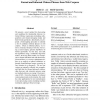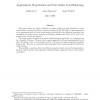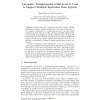1302 search results - page 29 / 261 » Fair Equivalence Relations |
EMNLP
2008
13 years 9 months ago
2008
We present a novel method for discovering and modeling the relationship between informal Chinese expressions (including colloquialisms and instant-messaging slang) and their forma...
CASCON
2006
13 years 9 months ago
2006
In this paper we present a test-driven approach to porting code from one object-oriented language to another. We derive an order for the porting of the code, along with a testing ...
SODA
2001
ACM
13 years 9 months ago
2001
ACM
This paper relates the notion of fairness in online routing and load balancing to vector majorization as developed by Hardy, Littlewood, and Polya 9]. We de ne -supermajorization ...
BVAI
2007
Springer
14 years 1 months ago
2007
Springer
We tested the efficiency of category learning when participants are provided only with pairs of objects, known to belong either to the same class (Positive Equivalence Constraints ...
CC
2008
Springer
13 years 9 months ago
2008
Springer
Portable low-level C programs must often support multiple equivalent in-memory layouts of data, due to the byte or bit order of the compiler, architecture, or external data formats...



